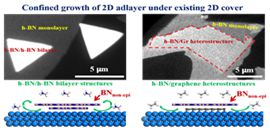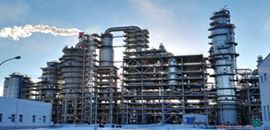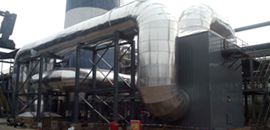Research News
-
 12 29, 2015DICP Researchers Confine Growth of Two-Dimensional (2D) Atomic Crystal Heterostructures and In-situ Dynamic Surface Characterization
12 29, 2015DICP Researchers Confine Growth of Two-Dimensional (2D) Atomic Crystal Heterostructures and In-situ Dynamic Surface Characterization
Nano and interfacial research group in the State Key Laboratory of Catalysis (SKLC) has recently made a new progress in confined growth of two-dimensional (2D) atomic crystal heterostructures and in-situ dynamic surface characterization. These new results have been published in the recent issue of ACS Nano (2015, 9, 11589-11598, http://pubs.acs.org/doi/abs/10.1021/acsnano.5b05509).
2D atomic crystal heterostructures have attracted increasing attentions recently. However, the controlled construction of the heterostructures remains as a challenge. A team lead by Prof. Qiang Fu and Prof. Xinhe Bao makes use of the newly developed photoemission electron microscopy (PEEM)/low energy electron microscopy (LEEM) system in SKLC and other surface science instruments to study chemistry at the interfaces between 2D materials and solid surfaces. They found that the interface can be regarded as a nanosized reactor. Accordingly, a concept “Chemistry under Cover” has been developed illustrating the 2D confinement effect on surface chemistry (Angew Chem Int Ed 2012, 51, 4856; PNAS 2014, 111, 17023; Nano Lett 2015, 15, 3616). Guided by this concept, they have explored the growth of one kind of 2D atomic crystal under the cover of the other kind of 2D atomic crystal, and succeed in construction of 2D atomic crystal heterostructures. These results suggest that the vertical stacking of 2D atomic crystals can be achieved through the confined growth under the cover, which provides a new route towards the growth of heterostructures. In the same issue, editor has highlighted this work with “Room to grow beneath h-BN” (http://pubs.acs.org/doi/full/10.1021/acsnano.5b07283).
DICP Researchers Confine Growth of Two-Dimensional (2D) Atomic Crystal Heterostructures and In-situ Dynamic Surface Characterization (Photo by Ying SHI)
This work is supported by the Natural Science Foundation of China, the Ministry of Science and Technology, the Chinese Academy of Sciences, the Ministry of Finance, and the iChEM program. (By Ying Shi)
-
 12 24, 2015The “Energy Storage Technology of Megawatt-scale Vanadium Flow Battery System” from wins the “China Machinery Industry Science and Technology Award”
12 24, 2015The “Energy Storage Technology of Megawatt-scale Vanadium Flow Battery System” from wins the “China Machinery Industry Science and Technology Award”
The program of “Energy Storage Technology of Megawatt-scale Vanadium Flow Battery System”, carried by Dalian Rongke Power Co. Ltd and the group of Energy Storage Division (DNL 17, acting minister: Li Xianfeng) Dalian Institute of Chemical Physics (DICP) has won the second prize in “2015 China machinery industry science and technology” on the Chinese mechanical engineering society annual meeting, held in Nanning, 20th November, 2015. Lead researcher Zhang Huamin of DICP was the first completer of the program.(Text/Photo by RONG Qian)
The “Energy Storage Technology of Megawatt-scale Vanadium Flow Battery System” from wins the “China Machinery Industry Science and Technology Award”(Photo by RONG Qian) -
 12 23, 2015Dalian Institute of Chemical Physics & Baoding Fengfan Co. Ltd. Set Up Joint R & D Center in BeijingDecember 20, a signing ceremony was held in Beijing Xiangshan Yihe hotel to set up the joint R & D center between Dalian Institute of Chemical Physics and Baoding Fengfan Co. Ltd.. Aisheng Feng, deputy director of the Dalian Institute of Chemical Physics, Yong Li, general manager of Baoding Sailing Co., representing both sides signed a bilateral strategic cooperation agreement to jointly build R & D center and technology development contract agreement.
12 23, 2015Dalian Institute of Chemical Physics & Baoding Fengfan Co. Ltd. Set Up Joint R & D Center in BeijingDecember 20, a signing ceremony was held in Beijing Xiangshan Yihe hotel to set up the joint R & D center between Dalian Institute of Chemical Physics and Baoding Fengfan Co. Ltd.. Aisheng Feng, deputy director of the Dalian Institute of Chemical Physics, Yong Li, general manager of Baoding Sailing Co., representing both sides signed a bilateral strategic cooperation agreement to jointly build R & D center and technology development contract agreement.
December 20, a signing ceremony was held in Beijing Xiangshan Yihe hotel to set up the joint R & D center between Dalian Institute of Chemical Physics and Baoding Fengfan Co. Ltd.. Aisheng Feng, deputy director of the Dalian Institute of Chemical Physics, Yong Li, general manager of Baoding Sailing Co., representing both sides signed a bilateral strategic cooperation agreement to jointly build R & D center and technology development contract agreement. Subsequently, Aisheng Feng and Baosheng Liu, Chairman of the board of Baoding Sailing Feng Co., Ltd., unveiling the joint R & D center together. Baoding Fengfan Co. Ltd. deputy general manager Zhijun Zhen, deputy general manager and chief engineer Yufeng Zhang, Technology Management Department manager Mengyang Wang, Planning Department manager Haitao Liu, Basic Research Department manager Baoguang Qu, office director Yulong Guo, Dalian Institute of Chemical Physics deputy science and technology Director Zhang Yu, Chief Researcher and DICP-Fengfan joint R & D center director Huamin Zhang, Energy Storage Department director Xianfeng Li, Advanced Battery Group director Hongzhang Zhang, Researcher Jingwang Yan, attended the signing ceremony.
Dalian Institute of Chemical Physics & Baoding Fengfan Co. Ltd. Set Up Joint R & D Center in Beijing(Photo by Zheng ZHAO)
In the future, both sides will take good use of the platform of the Joint R & D center to strengthen the close cooperation, to carry out extensive technological innovation and technology transfer, to finally promote the scientific research and industrialization of advanced batteries.(Text by Hongzhang ZHANG/Photo by Zheng ZHAO) -
 12 23, 2015Shenhua (Yulin) MTO Project Commissions SuccessfullyOn Dec. 15th,2015, Shenhua (Yulin) MTO plant began methanol feeding at 8:58 am, and the mixed-olefins gas started to be compressed into the Light Olefin Recovery Section at 11:38 am, this marked the successful start-up of Shenhua (Yulin) MTO project. This successful start-up again proved DMTO a advanced, mature, and reliable technology with completely independent intellectual property right of China.
12 23, 2015Shenhua (Yulin) MTO Project Commissions SuccessfullyOn Dec. 15th,2015, Shenhua (Yulin) MTO plant began methanol feeding at 8:58 am, and the mixed-olefins gas started to be compressed into the Light Olefin Recovery Section at 11:38 am, this marked the successful start-up of Shenhua (Yulin) MTO project. This successful start-up again proved DMTO a advanced, mature, and reliable technology with completely independent intellectual property right of China.
On Dec. 15th,2015, Shenhua (Yulin) MTO plant began methanol feeding at 8:58 am, and the mixed-olefins gas started to be compressed into the Light Olefin Recovery Section at 11:38 am, this marked the successful start-up of Shenhua (Yulin) MTO project. This successful start-up again proved DMTO a advanced, mature, and reliable technology with completely independent intellectual property right of China.
Since the first DMTO commercial plant Shenhua (Baotou) started up, Shenhua (Yulin) MTO plant is the ninth DMTO commercial plants on operation. The nine DMTO commercial plants on operation have reached a total olefin capacity of 5.2 million ton per year.(Text/ Photo by Project Department of SYN)
Shenhua (Yulin) MTO Project Commissions Successfully (Photo by Project Department of SYN) -
 12 22, 2015The Industrial Demonstration SCR System for Coking Process is Successfully CommissionedRecently, a low-temperature DeNOx industrial demonstration unit has been successfully carried out in Jiangsu Yizhou Coking Co., Ltd. for removal of NOx from coke oven flue gas. This unit was loaded with a kind of high-efficiency low-temperature DeNOx catalyst developed by DNL0901 from DICP.
12 22, 2015The Industrial Demonstration SCR System for Coking Process is Successfully CommissionedRecently, a low-temperature DeNOx industrial demonstration unit has been successfully carried out in Jiangsu Yizhou Coking Co., Ltd. for removal of NOx from coke oven flue gas. This unit was loaded with a kind of high-efficiency low-temperature DeNOx catalyst developed by DNL0901 from DICP.
Recently, a low-temperature DeNOx industrial demonstration unit has been successfully carried out in Jiangsu Yizhou Coking Co., Ltd. for removal of NOx from coke oven flue gas. This unit was loaded with a kind of high-efficiency low-temperature DeNOx catalyst developed by DNL0901 from DICP.
NOx emissions from coke oven flue gas have been a technological problem in the coking industry. Since 2013, DNL0901 has been developing SCR catalyst for NOx removal from coke oven flue gas. In 2014, an industrial pilot SCR system was commissioned and an instant operation success was achieved at Baofeng Energy Ltd, Yinchuan, Ningxia province. This efficient SCR catalyst showed a very high and stable NOx reduction efficiency with 98~99% during 1200 hours running. Based on these research works, DNL0901 from DICP, Jiangsu WOTE Environmental Protection Equipment Engineering Co. Ltd and Jiangsu Yizhou Coking Co., Ltd join together to establish the low-temperature DeNOx industrial demonstration unit for reduction of NOx emissions from the coke oven.
At 27 November 2015, this unit was put into operation successfully. According to the on-line CEMS system monitoring data, This efficient SCR catalyst showed a very high and stable NOx reduction efficiency with 90~95% and the concentration of NOx in effluent maintained less than70 mg/m3.
The Industrial Demonstration SCR System for Coking Process is Successfully Commissioned(Photo by Hao CHENG)
The successful operation of the unit has a great demonstration effect for the NOx reduction in the coking industry. The promotion of this technology will provide annual emission reduction of millions of tons of NOx and make a great contribution to atmospheric environmental management. (Text/ Photo by Hao CHENG)
-
 12 21, 2015The Energy Storage Technology of Vanadium Flow Battery from Rongke Power Has Won the 2015 “China's Original Technology Award” on the 15th China Economic ForumIn 18th December, 2015, the energy storage technology of the vanadium flow battery from Dalian Rongke Power Co. Ltd has won the 2015 “China’s Original Technology Award” on the 15th China Economic Forum. Dalian Institute of Chemical Physics has technology investment in Rongke Power. The prize-giving words are "the global leader in the energy storage technology of vanadium flow battery and the international standard maker in the industry”. The China Economic Forum is organized by China Daily, China Economic Weekly and Torch Center of the Ministry of Science and Technology
12 21, 2015The Energy Storage Technology of Vanadium Flow Battery from Rongke Power Has Won the 2015 “China's Original Technology Award” on the 15th China Economic ForumIn 18th December, 2015, the energy storage technology of the vanadium flow battery from Dalian Rongke Power Co. Ltd has won the 2015 “China’s Original Technology Award” on the 15th China Economic Forum. Dalian Institute of Chemical Physics has technology investment in Rongke Power. The prize-giving words are "the global leader in the energy storage technology of vanadium flow battery and the international standard maker in the industry”. The China Economic Forum is organized by China Daily, China Economic Weekly and Torch Center of the Ministry of Science and Technology
In 18th December, 2015, the energy storage technology of the vanadium flow battery from Dalian Rongke Power Co. Ltd has won the 2015 “China’s Original Technology Award” on the 15th China Economic Forum. Dalian Institute of Chemical Physics has technology investment in Rongke Power. The prize-giving words are "the global leader in the energy storage technology of vanadium flow battery and the international standard maker in the industry”. The China Economic Forum is organized by China Daily, China Economic Weekly and Torch Center of the Ministry of Science and Technology.(Text/ Photo by WANG Xiaoli)
The Energy Storage Technology of Vanadium Flow Battery from Rongke Power Has Won the 2015 “China's Original Technology Award” on the 15th China Economic Forum (Photo by WANG Xiaoli)